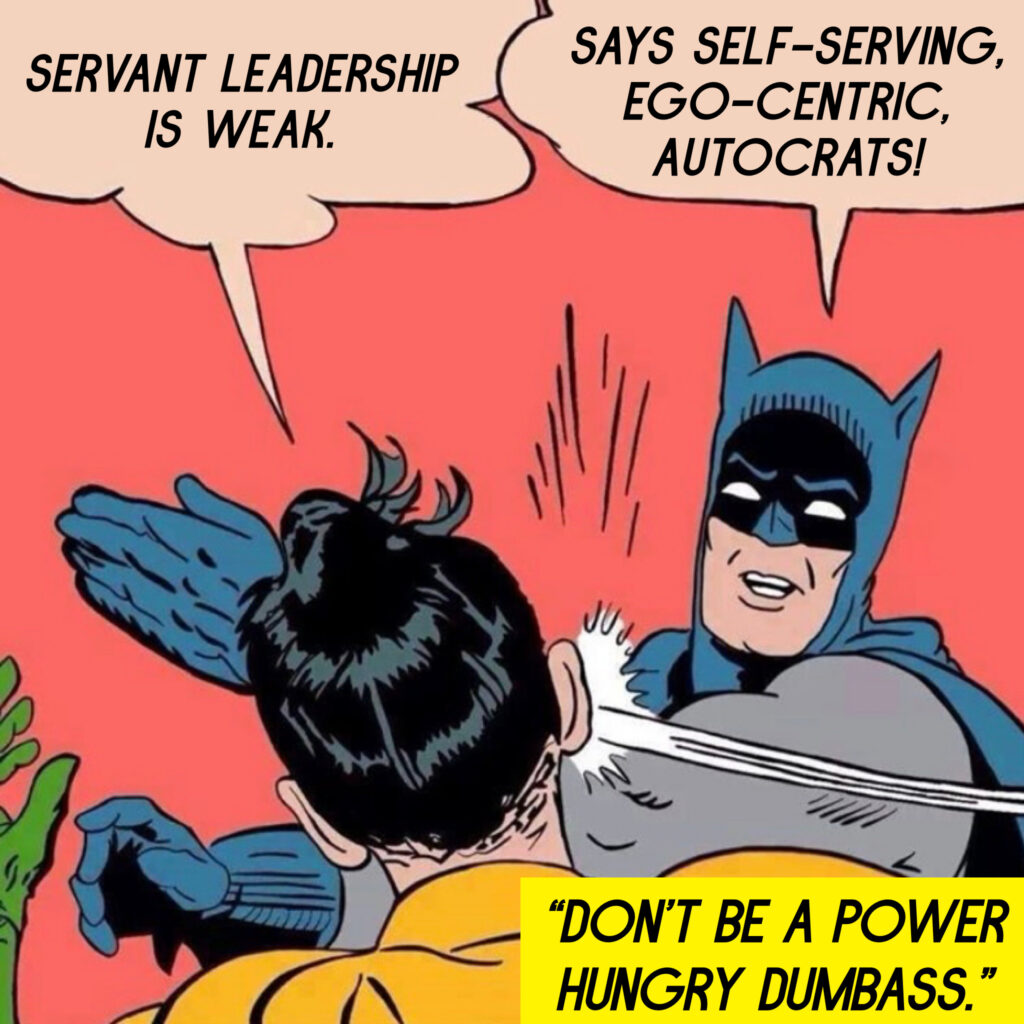
Recently, an otherwise informative webinar by a noted speaker spectacularly fell off the rails when the host ranted on his disdain for Servant Leadership; the leadership style practiced over thousands of years, though branded differently in the last few decades.
He began his argument by saying the idea of servant leadership sounds great in theory, just like Marxism sounds good on paper. But to him, it’s nothing more than virtue signaling that makes you look good, helps you sell books, and makes you the darling of wide-eyed, idealistic university students. With ludicrous fervor, he charged that it consistently leads to political repression and cultural and artistic censorship. It holds little more relevance than a reactionary swing of the pendulum from the 20th century’s top-down hierarchical, patriarchal, autocratic, command-and-control, dictatorial type of leadership.
While he may have correctly noted last century’s panache for authoritarianism, he mistakenly believed that servant leadership meant managers and leaders should be subservient to their subordinates, catering to the frontline’s every need and whim. As such, they become concerned over every distraction in such an extreme manner that it creates dependency, unexpectedly handicaps the team, and stifles their progress and potential. Servant leadership, he contended, diminishes leadership power and doesn’t allow employees to think for themselves, take ownership, or get to lead themselves with self-responsibility. He believed it makes managers their indentured servants — a patently false assertion.
He then cited a long-debunked notion that they’re naturally inclined to step in and fix problems when they occur, including finishing a task for employees. This inclination and major limitation make it impossible to give employees’ hard work. If they believe their manager will step in to take care of any problems, they won’t independently resolve issues. The temptation to sit back and exert less effort in their daily tasks and productivity will be too strong.
He dabbled with a warped messiah complex, cloaked in a ridiculous sentiment that if you supply an employee with a crutch; they will only learn to limp; they will never be able to run, and they will always need you to prop them up. His confusion between Theory X and Theory Y styles of management – authoritarian (Theory X) and participative (Theory Y) did not help his cause with me.
He then extolled the virtues of Human-centered leadership, which okay, call it what you want. Every 7-10 years, the leadership industry stays relevant by repackaging old concepts into a new model for a new age. Whatever. I’m not interested in nitpicking on how the industry reintroduces old concepts.
This man’s fundamental misunderstanding of servant leadership shocked me and damaged his credibility as an authority on leadership in my eyes. Most upsetting to me — he spouted notions of servant leadership that no practicing servant leader uses. Unfortunately, he has a platform, so many did and will continue to believe him. He cannibalized one leadership theory in favor of another, despite it sharing many of the same tenets. A sleight of hand, his acolytes didn’t notice, though I did see some disapproval from clear-eyed observers. Ironically, the whole exercise seemed a lot like virtue signaling to make him look good, help him sell books, and make him an object of interest to an idealistic generation.
At first, I thought he railed against servant leadership because it is the opposite of authoritarian leadership; and like many old guards in power, he may be desperate to retain positional relevance. The desired middle ground he implored listeners to follow turned out to be a repackaged leadership system you too could learn by enrolling in his multi-month, middle of the road course.
Good grief.
Accomplish the mission, deliver for the client, and make a positive impact is not particularly complicated. It’s the triple bottom line of positive results for people, the planet, and profit. It’s simple, not easy, but simple. It involves collaborative support, empathy, engagement, and developing relationships with team members, which, when done correctly, improves your leadership and respect by igniting creativity, innovation, and personal initiative.
So…servant leadership. No duh. Successful leaders have exhibited this since before and including Jesus, through to Pope Francis. From Abraham Lincoln to Angela Merkel, Nelson Mandela to Malala Yousafzai, Ken Blanchard to Simon Sinek. Companies from Starbucks to Southwest Airlines and Chick-fil-A to Popeye’s get this.
The two aspects of servant leadership unsurprisingly are servant and leadership. The leadership part is about vision, direction, and goals. Leadership is about going somewhere, and it’s the leader’s responsibility to keep those elements aligned. Once the vision, direction, and goals become apparent, the servant part comes to play. The leader’s job is to help people act according to the vision, values, and goals and help them serve the customers and the mission in the best way possible.
The servant leader leads by example, shows people why their job is important, encourages collaboration and engagement, helps the team develop, cares for and about the welfare of team members, and asks for feedback to improve.

Servant leadership is about setting a vision, enrolling people who believe in that vision, and helping them use the best of their skills and abilities to achieve the vision.
There is no subservience or naivety in the equation. To be successful, it requires strength of character, humility, empathy, and accountability. That’s why it works.
The reason why so many entrenched business owners and managers have trouble accepting alternatives to “it’s my way, or the highway” thinking is that their inflated ego gets in the way. They fear the perceived loss of control, failing to realize that consolidating power isn’t a sign of strength but vulnerability.
Keeping everyone aligned and helping those closest to your customers, patients, students, members, or flock, to succeed and provide the best experience for all is not a new style of leading; it’s one of the oldest, but it remains rare. It’s not easy, which explains why many do not put in the necessary effort to practice it.
My bias is that of a stoic servant leader who uses situational leadership as a model. Perfection isn’t the goal, particularly in a post-2020 world. Adaptability, as always, remains the key to success. If you need an expensive course to give you confidence and a sense of control, I can gladly offer you one. My preference is that you remain curious, eschew authoritarian tendencies, build your capacity for empathy, and rather than protect your power, devote your energy to managing better and leading well.